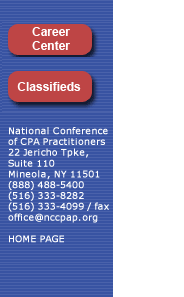

| |
|
|
|
|
|
|
|
|
|
|
|
|
|

November 2004
MEMBERS’
CORNER
BY STANLEY TEPPER, CPA, MBA
Custodial Accounts- Marvin Kalickstein, a long time member of our chapter wants to supplement last month's article about custodial accounts. The column indicated that "If the parent is the custodian, and dies during the child's minority, the account is included in the parent's estate." This will only happen Marv writes if the assets in the custodial account were gifts by that donor custodian. It would not apply in custodial accounts whose assets were not gifted by that custodian.
Crummey Powers- Last month's column on the subject of Crummey Powers excerpted from the tax newsletter of the law firm of Certilman Balin Adler and Hyman, LLP was not printed in its entirety due to space limitations. The full article follows:
Crummey Powers-
It is possible to fund a generation-skipping trust with life insurance, but anyone who intends to do so should be aware of a critical pitfall. Generally, life insurance trusts grant the beneficiaries Crummey powers to allow transfers to the trust to qualify for the gift tax annual exclusion. A Crummey power is a temporary right granted to a trust beneficiary to withdraw property gifted to the trust. The beneficiary must be notified of the gift and the Crummey power, which lapses after a certain period. Without this power, the gift of life insurance would not be a gift of a present interest to the trust beneficiaries, and would therefore not qualify for the annual exclusion.
The problem is that the lapse of a Crummey right could be considered a taxable release of a general power of appointment. In other words, unless the power is structured correctly, the beneficiary might make a taxable gift by allowing the power to lapse. This would cause a portion of the trust to be included in the beneficiary's estate. A generation skipping insurance trust, in order to be effective, must be drafted to avoid this situation.
Section 2041(e) provides a safe harbor of $5,000 or 5% of the trust principal (the "five-and-five" safe harbor). So, limiting the gift to $5,000 per year will generally allow the Crummey power to lapse without a taxable release by the beneficiary. But if the grantor intends to take full advantage of gift tax annual exclusions ($11,000 per year per recipient) for transfers to the trust, he or she could use a "hanging power."
The "hanging power" technique uses the entire $11,000 exclusion, granting the beneficiary the temporary right to withdraw that amount. But when that power lapses, only the amount that can be covered by the five-and-five safe harbor is allowed to lapse. The power to withdraw the remaining amount "hangs" until the next year, and does not lapse until the five-and-five safe harbor is no longer used to cover other lapsing powers.
The previous mentioned law firm's newsletter is also the source for this article on Generation Skipping Trust (GST) tax rules-
IRS Issues Guidance on Predeceased Parent Exception for GST Tax Rules
The IRS has issued guidance regarding the "predeceased parent rule," which provides an exception to the rules for determining the generation assignment of a transferee of property of GST tax purpose under §2651.
The general rule is that a transfer, either outright or in trust, to a grandchild of the transferor is a direct skip. The predeceased parent rule provides that if the parent of the transferor's grandchild was a lineal descendant of the transferor and that parent was deceased at the time of the transfer, the grandchild is treated as the child of the transferor for purposes of determining whether the transfer was a direct skip. The rule also applies to transfers in trust and transfers made to a grandchild of the transferor's spouse or former spouse. In addition, the rule provides that, if a transferor's grandchild is treated as a child for GST tax purposes, the lineal descendants of that grandchild also move up one-generation level.
The proposed regulations implement statutory changes that expanded the application of the predeceased parent rule to additional transfers and recipients. They also make the rule easier to apply and provide that certain adoptions may reduce the GST tax.
Executor Fees- Newsday recently summarized the rules for executor fees.
The Rules: New York law, on a graduated scale, sets Executors commissions as follows:
- For receiving and paying out sums up to $100,000 – 5 percent
- Additional sums up to $200,000 – 4 percent
- Additional sums up to $700,000 – 3 percent
- Additional sums up to $4 million - 2.5 percent
- All sums above $5 million – percent
Each executor is entitled to a separate commission based on those rates. The size of the estate is valued at different times during the probate process - the period when a will's provisions are being carried out. Only assets subject to probate - those in the decedent's name alone and those with no named beneficiary - are included. Certain assets, such as specific bequests, are not included.
Separate rules on commissions apply if there are more than two executors. Even if your co-executor waives her fee, you still would be entitled to your commission.
The will may contain provisions to pay commission amounts other than the statutory rates. For example, the will may provide that a corporate executor may be paid according to its fee schedule.
Your commission is subject to income tax, and must be declared as "other income" on your tax return.
Family Financing of Residence- One of our members came across this article in JK LASSER while researching a tax problem for a client.
The Tax Court allowed a taxpayer to deduct mortgage interest payments on a loan that his brother obtained when the taxpayer’s poor credit rating prevented him from obtaining a mortgage loan. The brother bought the house but allowed the taxpayer and his wife to live there on the condition that they make the mortgage payments directly to the bank.
The IRS disallowed the taxpayer’s deduction for the mortgage interest on the grounds that he was not liable for the mortgage debt; his brother was. However, the Tax Court allowed the deduction, holding that the taxpayer was the equitable owner of the home and that he was legally obligated to his brother to pay off the mortgage.
Carol C. Markman- National President of NCCPAP and a former president of our Nassau/Suffolk chapter has been elected to serve on the board of Planned Parenthood of Nassau County ( PPNC).
Individual Retirement Accounts ( IRA )- Ed Slott a member of our chapter and editor of Ed Slott's IRA Advisor has given this writer permision to excerpt sections of his publication for inclusion in this column. Ed can be reached at 1-800-221-1809.
IRA Update
Will IRAs Receive Federal Creditor Protection?
The U.S. Supreme Court has agreed to decide whether IRAs receive federal creditor protection under ERISA (Employee Retirement Income Security Act of 1974), the Act that currently protects qualified plans from creditors. This decision will resolve a split on the issue among Appeals Courts. The case involves an Arkansas couple that rolled over their company plan funds to IRAs and filed for Bankruptcy. They probably should have kept the funds in their plan, but then we wouldn’t have this case to be talking about. This ruling will have a huge impact on every IRA in the country, and possibly inherited IRAs as well. Currently, many people keep their retirement money in their qualified plan because of the federal creditor protection. If IRAs are determined to be afforded this same protection, expect a tidal wave of IRA rollovers.
Separate Account Rules Amended by the IRS
The IRS has amended the IRA distribution rules that apply to the separate share rules when you have more than one beneficiary of your IRA. When you name more than one beneficiary, the general rule is that you use the age of the oldest (or the beneficiary with the shortest life expectancy) to compute required minimum distributions. If you want each of the individual beneficiaries to be able to use their own life expectancies to calculate their post-death RMDs, then separate accounts must be created. Your beneficiaries can do this by splitting the inherited IRA into several inherited IRAs one for each of them. This way each beneficiary is the sole beneficiary on each inherited IRA. To be effective for separate account treatment so that each beneficiary can use his or her own life expectancy, the split must be done no later than the end of the year following the year of the IRA owner’s death. The inherited IRA can still be split after that but in that case there will be no separate share treatment.
What’s Changed?
Under the old rules the split was not effective for separate account treatment until the year after the split. That meant that beneficiaries would have to split by the end of the year of death in order for the split to be effective for the following year when they must take their first RMD. That was a problem if an IRA owner died near year-end. Now the IRS has amended the rules to say that if the split is done in the year following the year of the IRA owner’s death, the split is effective for that year.
